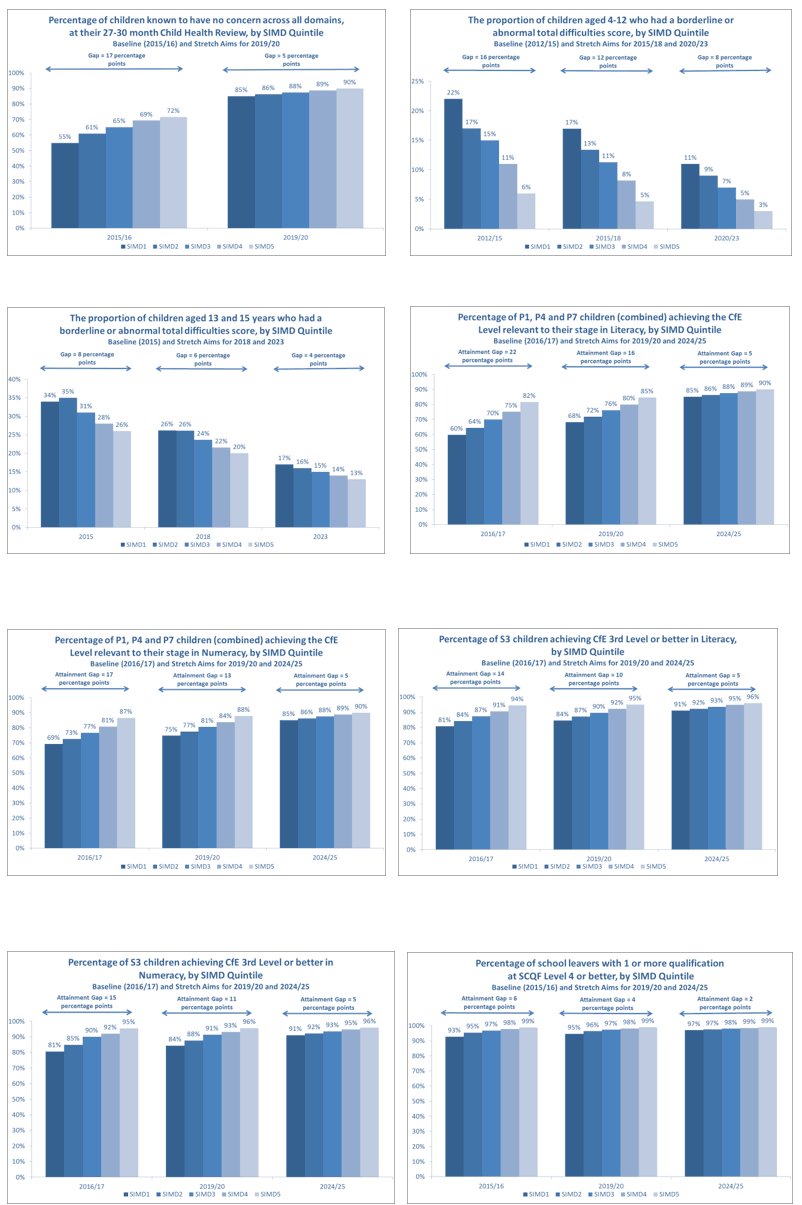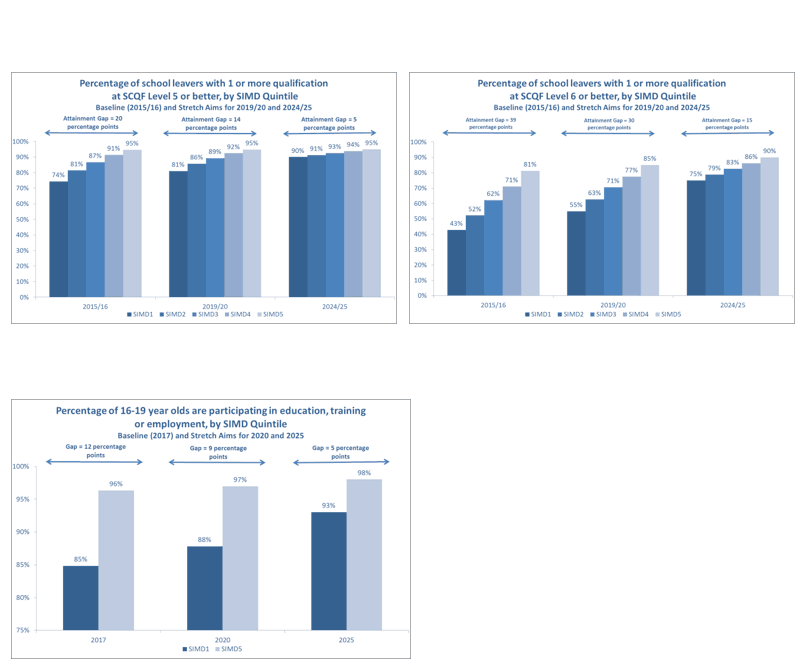2018 national improvement framework and improvement plan
The framework sets out activity the Scottish Government and partners will take to drive improvement for children and young people.
Measuring the attainment gap
The Scottish Government has made clear its commitment to closing the poverty-related attainment gap between children and young people from the least and most disadvantaged communities. Ministers are committed to making demonstrable progress in closing the gap during the lifetime of this Parliament, and to substantially eliminate it in the next decade.
In line with the commitment set out in the 2017 NIF & Improvement Plan, we have worked with key stakeholders to explore and agree what specific measures were felt to drive improvement most usefully across all stages of a child or young person's life. We also consulted on proposals for measuring the gap and milestones towards closing it; focusing on the impact of the education system as a whole and using a range of measures that reflect key stages of the learner journey and the breadth of issues that can impact on attainment. These same proposals were based on the following key principles:
- considering the difference in attainment between those children and young people from SIMD quintiles 1 and 5. However, we recognise the importance of increasing attainment for all children and young people and therefore proposed setting stretch aims for all 5 SIMD quintiles;
- focusing on a single measure is neither helpful or meaningful and would provide a false and limited picture;
- measures and milestones should be relatively simple to measure and report against;
- there needs to be a clear line of sight from the agreed measures and milestones to the priorities set out in the National Improvement Framework;
- there should be a focus on literacy, numeracy and health and wellbeing;
- the focus should be across the age ranges – from 3-18;
- they should be a credible set of measures – understood to fairly reflect progress in closing the poverty-related attainment gap;
- the need to avoid perverse incentives through milestones or stretch aims.
The consultation closed on 20 November 2017 and the Scottish Government received 102 responses from a range of interests, including 10 local authorities, and 38 individuals.
Support was generally expressed for the approach we proposed: a basket of 8 key measures to assess progress, supported by a series of 17 sub-measures. Respondents agreed that a single measure could not describe the attainment gap appropriately.
There were concerns, however, that we had not identified sufficient key measures adequately to address the complexities of the education system. In particular, it was felt that while the proposed measures might measure attainment, they did not properly address health and wellbeing; and that a focus on the achievement of Scottish Credit and Qualifications Framework ( SCQF) levels 5 and 6 risked excluding those young people who would never achieve level 5 from efforts to close the gap.
As a result, we have decided to include an additional three measures in the basket of key measures: two additional health and wellbeing measures, covering the social, emotional and behavioural development of children and young people (these were included as sub-measures in the consultation paper) and one new and additional measure around the achievement of one or more SCQF level 4 qualifications upon leaving school. This results in a basket of 11 key measures, supported by 15 sub-measures.
The majority of consultation responses supported the use of stretch aims, which will be retained much as set out in the consultation. The only changes to these are the inclusion of the 2016/17 achievement of a CfE level data as the baseline for the 4 broad general education achievement measures and the inclusion of stretch aims for the 3 new key measures.
The consultation also highlighted the need to do more to make the terms and concept of SCQF levels more accessible to parents, employers and the wider public. We are aware that this is an issue, and the SCQF Partnership has already undertaken to develop communications to raise the profile and understanding of the SCQF. We will work with the SCQF Partnership to develop a robust, effective communications strategy to allow those not directly involved in the school system to reach a fuller understanding of the SCQF.
A number of responses echoed the concerns highlighted in the consultation paper itself, of using the SIMD as our deprivation indicator. We recognise that SIMD is not a measure of individual circumstances, it is not sensitive to those children and young people from very disadvantaged backgrounds living in more affluent areas, nor does it capture rural deprivation particularly well.
A Research Strategy for Scottish Education (April 2017) committed to exploring work on "a study on the long-term development of a bespoke index of social background which will create individual-level (as opposed to area-based) data involving consideration of the data collected at school registration." This study to explore the feasibility of developing a new individual index of social background will be taken forward as a priority in 2018.
At present, however, we believe that using SIMD presents the best way forward. The use of stretch aims across all SIMD quintiles helps to mitigate the risk of leaving behind those disadvantaged children and young people living in affluent areas, by ensuring we seek to raise attainment for all, rather than focusing solely on particular SIMD quintiles.
Some responses raised concerns about the use of the achievement of a CfE level data as a measure of the gap, given that it is based on teachers' professional judgement rather than a test or assessment. We consider that achievement of a CfE level is the key outcome indicator for children and young people's progress in the broad general education and that any sort of test or assessment cannot fully encapsulate the full range of learning that pupils should demonstrate in order to reach the appropriate CfE level for their stage. This includes the Scottish National Standardised Assessments ( SNSA). Only a wide range of evidence, including observations in the classroom, written or course work, etc can provide this. The potential variation in standards applied did, however, provide the rationale for the introduction of SNSA, the development by Education Scotland of the curriculum benchmarks and the work led by Education Scotland on moderation of teachers' professional judgements and assessment, all of which is designed to support more consistent judgements. Given this activity and the growing confidence expressed by local authorities in the consistency of teachers' professional judgement, we have retained the 4 broad general education achievement measures in the basket of key measures.
The finalised basket of key measures, sub-measures and stretch aims are shown below:
Table 1 – key measures (11)
| Measure | All children % | Most disadvantaged (bottom 20% SIMD) % | Least disadvantaged (top 20% SIMD) % | Gap (percentage points) |
|---|---|---|---|---|
| 27-30 month review (Children showing no concerns across all domains) | 63.7 | 54.8 | 71.7 | 16.8 |
| HWB: Children total difficulties score (age 4-12) | 14 | 22 | 6 | 16 |
| HWB: Children total difficulties score (age 13&15) | 31 | 34 | 26 | 8 |
| Primary – Literacy (P1, P4, P7 combined) | 69.2 | 59.8 | 81.5 | 21.8 |
| Secondary Literacy (S3, 3rd level or better) | 87.1 | 80.8 | 94.4 | 13.6 |
| Primary – Numeracy (P1, P4, P7 combined) | 76.4 | 69.2 | 86.5 | 17.3 |
| Secondary Numeracy (S3, 3rd level or better) | 88.2 | 80.7 | 95.5 | 14.8 |
| SCQF 4 or above (1 or more on leaving school) | 96.3 | 92.8 | 98.8 | 6 |
| SCQF 5 or above (1 or more on leaving school) | 85.6 | 74.4 | 94.7 | 20.3 |
| SCQF 6 or above (1 or more on leaving school) | 61.7 | 42.7 | 81.2 | 38.5 |
| Participation measure | 91.1 | 84.8 | 96.3 | 11.5 |
Table 2 – sub measures (15)
| Measure | All children % | Most disadvantaged (bottom 20% SIMD) % | Least disadvantaged (top 20% SIMD) % | Gap (percentage points) |
|---|---|---|---|---|
| Detailed attainment sub-measures | ||||
| P1 – Literacy | 74 | 65 | 85 | 20 |
| P4 – Literacy | 68 | 58 | 80 | 22 |
| P7 – Literacy | 66 | 56 | 79 | 23 |
| P1 – Numeracy | 83 | 78 | 92 | 14 |
| P4 – Numeracy | 75 | 67 | 85 | 18 |
| P7 – Numeracy | 70 | 62 | 82 | 21 |
| Sub-measures known to impact on attainment | ||||
| HWB: 27-30 month review uptake | 88 | 86 | 89 | 3 |
| HWB: Mental wellbeing score: 13 year old boys | 51.4 | 49.9 | 52.6 | 2.7 |
| HWB: Mental wellbeing score: 13 year old girls | 48.2 | 47.2 | 49.1 | 1.9 |
| HWB: Mental wellbeing score: 15 year old boys | 50.1 | 49.3 | 50.6 | 1.3 |
| HWB: Mental wellbeing score: 15 year old girls | 44.4 | 43.7 | 45.8 | 2.1 |
| Primary attendance rates | 95.1 | 93.3 | 96.7 | 3.4 |
| Secondary attendance rates | 91.8 | 88.7 | 94.5 | 5.8 |
| Primary exclusion rates (rates per 1000 pupils) | 9.0 | 19.0 | 2.1 | 16.9 |
| Secondary exclusion rates (rates per 1000 pupils) | 49.6 | 95.2 | 15.2 | 80 |
Stretch Aims


Contact
There is a problem
Thanks for your feedback